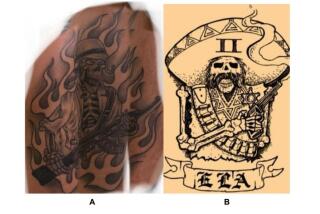Simi Valley ‘Inundated’ With Graffiti
Although little gang violence has occurred in Simi Valley over the past two years, the city has been “inundated” with graffiti that have caused more than $200,000 damage in the past seven months alone, local officials say.
The city’s gang and graffiti problems are spelled out in a new report prepared by Simi Valley police, code enforcement officers and the city crews who clean up vandalism.
“We have managed to control our gang problem, but we do have a bit of a graffiti problem,” Mayor Greg Stratton said Friday. “Somehow, this has become the new sport of the younger set.”
The report on gang and tagger activity is scheduled to be discussed Tuesday at a rare joint meeting of the Simi Valley City Council and the boards of the Simi Valley Unified School District and the Rancho Simi Recreation and Park District. The meeting begins at 6:30 p.m. at City Hall.
Simi Valley has three gangs with about 100 members altogether, police say. After a series of gang-related drive-by shootings between December, 1989, and July, 1991, local police stepped up enforcement, leading to a decrease in gang-related crime, the report says.
But graffiti incidents, not linked to gangs, have been increasing in Simi Valley, authorities concluded.
Taggers usually use spray paint or markers to leave their marks on walls, street signs and other highly visible outdoor locations. Although taggers sometimes operate in small groups, they generally do not commit violent crimes, police say.
Nevertheless, Simi Valley officers are anxious to curtail tagging because of the property damage it causes and because it can lead to more serious crimes.
“We have not seen violence between these tagger groups in Simi Valley, although there has been some violence between tagger groups elsewhere in Southern California,” said Simi Valley Police Capt. Dick Wright. “Obviously, I think the potential is there because it’s happened in the San Fernando Valley.”
Wright referred to a fatal shooting Feb. 22 at Reseda High School. The victim and the teen-ager convicted in that case were members of rival graffiti crews, witnesses testified at the trial.
Because of a rise in graffiti incidents during the past two years, Simi Valley police last October began separating them from other vandalism reports and recording them on a computer. The new tracking system makes it easier to link graffiti offenders to more than one incident, Wright said.
During 1992, 2,196 graffiti incidents were tallied in Simi Valley. Since the beginning of this year, another 1,214 cases have been counted. Police made 177 arrests last year for vandalism, including graffiti offenses.
Officers often learn about the vandalism from the city’s 24-hour graffiti hot line, which receives tips on where damage has occurred.
The city’s cleanup crews say they remove most graffiti within two days. City officials say prompt removal is one of the best weapons against graffiti because it gives a tagger less time to “enjoy” the vandalism and decreases the likelihood of a response by rival taggers.
In 1992, the city spent $210,800 investigating and removing graffiti, the report says.
“It expends a lot of public funds that could be used for other services to the community,” said Joe Hreha, who oversees the graffiti hot line and code enforcement services.
Hreha said that to date, all Simi Valley property owners who have incurred graffiti damage have cooperated with city cleanup efforts. City crews remove graffiti from private property at no charge if the owner signs a liability waiver, Hreha said.
“It is destructive,” Stratton said. “It is part of what we think causes a community not to be proud of itself and to go downhill.”
Graffiti can discourage business owners from relocating to Simi Valley, the mayor said. “Most of them equate the graffiti with the crime that goes on in Los Angeles,” he said. “So they wouldn’t want to locate in the area.”
At Tuesday’s meeting, Stratton and other elected officials are expected to talk about ways to crack down on taggers.
Simi Valley’s graffiti ordinance, adopted in 1990, prohibits the sale of spray paint to minors. It has a provision that makes parents liable for graffiti damage caused by their minor children, but the city has not enforced this provision, officials said.
Similarly, the law allows the city to offer rewards to people who provide tips leading to the conviction of graffiti vandals, but no such program has been started in Simi Valley.
Rewards for Graffiti Tip-Offs
The city of Thousand Oaks offers monetary rewards to residents who witness graffiti “taggers” at work and inform police, leading to the vandals’ arrest.
Tipsters may remain anonymous and may be eligible for rewards up to $2,000, depending on the amount of property damage, for identifying anyone they spot applying graffiti on public property in the city.
Residents who can tip authorities off to vandalism should call the Ventura County Sheriff’s Department at 494-8276 between 7 a.m. and 2 a.m., or call 911 if they witness a tagger in the act.
Those who wish to remain anonymous will be identified only by a special number assigned to them when they report a suspected vandal. The reward system was adopted in January, 1990.
FYI
To report graffiti to Simi Valley cleanup crews, call the city’s 24-hour hot-line number: 583-6333. Officials ask for a description of the graffiti and precise location. City crews also will remove graffiti on private property at no charge if the owners sign a liability waiver.
More to Read
Sign up for Essential California
The most important California stories and recommendations in your inbox every morning.
You may occasionally receive promotional content from the Los Angeles Times.










